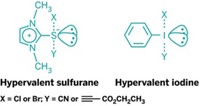Advertisement
Grab your lab coat. Let's get started
Welcome!
Welcome!
Create an account below to get 6 C&EN articles per month, receive newsletters and more - all free.
It seems this is your first time logging in online. Please enter the following information to continue.
As an ACS member you automatically get access to this site. All we need is few more details to create your reading experience.
Not you? Sign in with a different account.
Not you? Sign in with a different account.
ERROR 1
ERROR 1
ERROR 2
ERROR 2
ERROR 2
ERROR 2
ERROR 2
Password and Confirm password must match.
If you have an ACS member number, please enter it here so we can link this account to your membership. (optional)
ERROR 2
ACS values your privacy. By submitting your information, you are gaining access to C&EN and subscribing to our weekly newsletter. We use the information you provide to make your reading experience better, and we will never sell your data to third party members.
Synthesis
A new edition of fluoroalkyl additions
Chemists develop a convenient approach to safely using tetrafluoroethylene in organic synthesis
by Stephen K. Ritter
July 24, 2017
| A version of this story appeared in
Volume 95, Issue 30

Synthetic organofluorine chemistry has matured by leaps and bounds over the past decade. Yet one limitation has been the lack of basic methods that go beyond adding fluorine and fluoromethyl functional groups to organic compounds to include fluoroethyl groups. A research team led by Jinbo Hu of Shanghai Institute of Organic Chemistry has come up with a convenient and safe solution using tetrafluoroethylene as a reagent (Angew. Chem. Int. Ed. 2017, DOI: 10.1002/anie.201705734). Tetrafluoroethylene, CF2=CF2, is one of the most important bulk industrial fluorochemicals. But because of special needs for handling the suspected carcinogen and potentially explosive gas, many academic synthetic organic research groups are not equipped or permitted to use CF2=CF2. Hu’s group developed a breakthrough procedure to generate CF2=CF2 on the fly by dimerizing difluorocarbene generated under mild conditions from the commonly used fluorinating reagent (trifluoromethyl)trimethylsilane, (CH3)3SiCF3. In a tandem reactor system, the researchers convert (CH3)3SiCF3 to CF2=CF2 using sodium iodide as a catalyst in one chamber, then transfer CF2=CF2 to an adjacent chamber containing combinations of nucleophilic and electrophilic reagents. With this method, the team carried out pentafluoroethylation of aryl and heteroaryl iodides, (aryloxy)tetrafluoroethylation of an aryl iodide, and addition of tetrafluoroethyl groups to heteroatoms in aryl and alkyl compounds. The new approach promises to complement previous reactions to add fluoroethyl groups and accelerate the use of tetrafluoroethylene as a fluorinated C2 building block, Hu says.




Join the conversation
Contact the reporter
Submit a Letter to the Editor for publication
Engage with us on Twitter